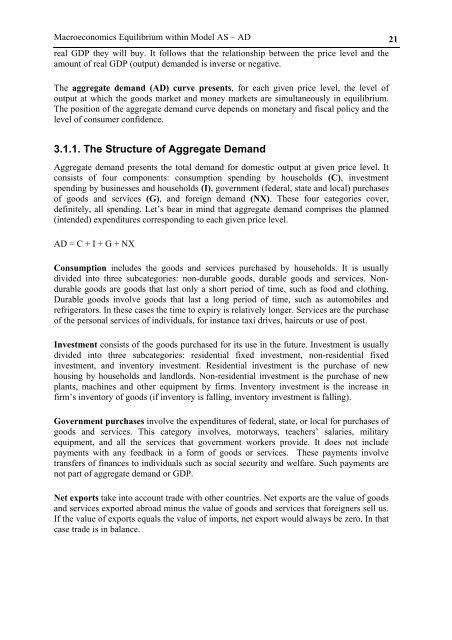MacroeconomicsI_working_version (1)
Create successful ePaper yourself
Turn your PDF publications into a flip-book with our unique Google optimized e-Paper software.
Macroeconomics Equilibrium within Model AS – AD 21<br />
real GDP they will buy. It follows that the relationship between the price level and the<br />
amount of real GDP (output) demanded is inverse or negative.<br />
The aggregate demand (AD) curve presents, for each given price level, the level of<br />
output at which the goods market and money markets are simultaneously in equilibrium.<br />
The position of the aggregate demand curve depends on monetary and fiscal policy and the<br />
level of consumer confidence.<br />
3.1.1. The Structure of Aggregate Demand<br />
Aggregate demand presents the total demand for domestic output at given price level. It<br />
consists of four components: consumption spending by households (C), investment<br />
spending by businesses and households (I), government (federal, state and local) purchases<br />
of goods and services (G), and foreign demand (NX). These four categories cover,<br />
definitely, all spending. Let’s bear in mind that aggregate demand comprises the planned<br />
(intended) expenditures corresponding to each given price level.<br />
AD = C + I + G + NX<br />
Consumption includes the goods and services purchased by households. It is usually<br />
divided into three subcategories: non-durable goods, durable goods and services. Nondurable<br />
goods are goods that last only a short period of time, such as food and clothing.<br />
Durable goods involve goods that last a long period of time, such as automobiles and<br />
refrigerators. In these cases the time to expiry is relatively longer. Services are the purchase<br />
of the personal services of individuals, for instance taxi drives, haircuts or use of post.<br />
Investment consists of the goods purchased for its use in the future. Investment is usually<br />
divided into three subcategories: residential fixed investment, non-residential fixed<br />
investment, and inventory investment. Residential investment is the purchase of new<br />
housing by households and landlords. Non-residential investment is the purchase of new<br />
plants, machines and other equipment by firms. Inventory investment is the increase in<br />
firm’s inventory of goods (if inventory is falling, inventory investment is falling).<br />
Government purchases involve the expenditures of federal, state, or local for purchases of<br />
goods and services. This category involves, motorways, teachers’ salaries, military<br />
equipment, and all the services that government workers provide. It does not include<br />
payments with any feedback in a form of goods or services. These payments involve<br />
transfers of finances to individuals such as social security and welfare. Such payments are<br />
not part of aggregate demand or GDP.<br />
Net exports take into account trade with other countries. Net exports are the value of goods<br />
and services exported abroad minus the value of goods and services that foreigners sell us.<br />
If the value of exports equals the value of imports, net export would always be zero. In that<br />
case trade is in balance.




